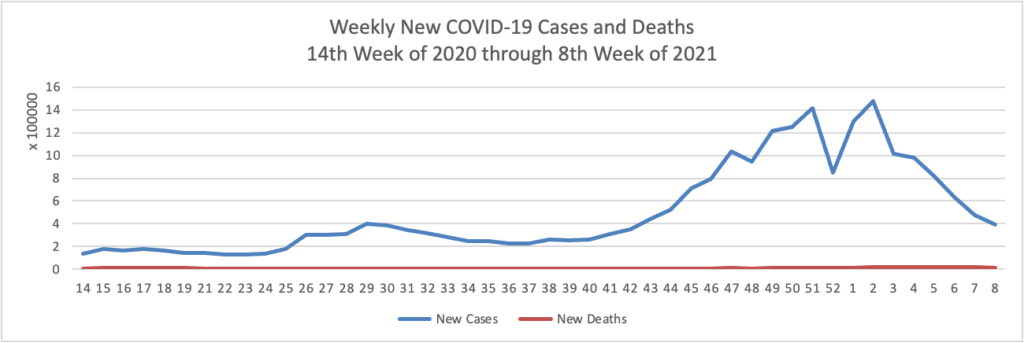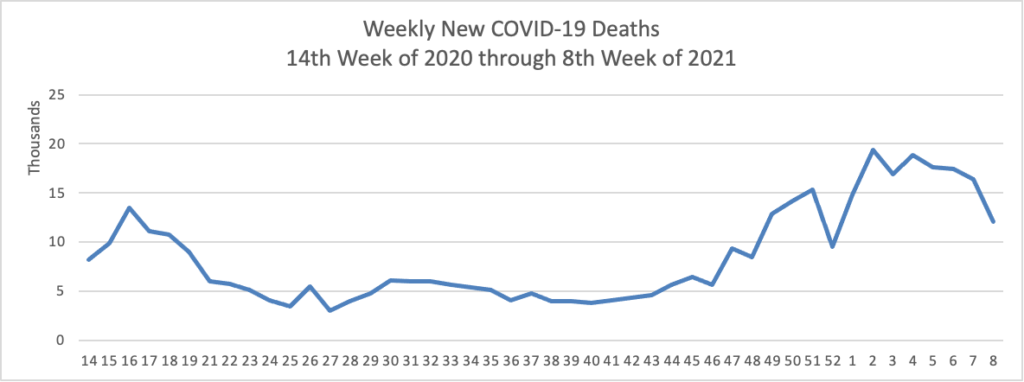Monday Roundup

The Wall Street Journal reports that
The House [of Representatives] looked on track to pass the latest version of the $1.9 trillion coronavirus relief package later this week, as liberal Democrats swallowed their frustration with the Senate’s changes and prepared to approve the bill for a second time.
The House is expected to narrowly pass the bill Tuesday or Wednesday, sending it to the White House for President Biden’s signature. House Majority Leader Steny Hoyer (D., Md.) had initially said the House would take its first procedural vote on the bill Monday, but processing the bill’s Senate paperwork pushed the vote slightly later in the week, aides said.
In COVID-19 news
- The Centers for Disease Control today released guidance for those who are fully vaccinated against the disease (meaning two weeks after the final dose).
- The Biden Administration announced “an effort to invest $250 million to encourage COVID-19 safety and vaccination among underserved populations. The U.S. Department of Health and Human Services (HHS) Office of Minority Health (OMH) will offer the funding as health literacy grants to localities, who will partner with community-based organizations, to reach racial and ethnic minority, rural and other vulnerable populations. The new initiative – Advancing Health Literacy to Enhance Equitable Community Responses to COVID-19 – is expected to fund approximately 30 projects in urban communities and 43 projects in rural communities for two years. “
- The Food and Drug Administration has given emergency use authorization for “the Cue COVID-19 Test for Home and Over The Counter (OTC) Use. The product is a molecular nucleic acid amplification test (NAAT) that is intended to detect genetic material from SARS-CoV-2 virus present in the nostrils. The test is the first molecular test authorized for at-home use without a prescription.” Here’s a link to the Cue Health website.
In other healthcare news —
- Healthcare Dive reports that “for the first time since Fair Health started tracking monthly telehealth claims, COVID-19 became one of the top five diagnoses in the U.S. in December as cases surged, the nonprofit said in a report released Thursday. Overall, telehealth claim lines increased 2,817% year over year, rising from just 0.22% of all medical claim lines in December 2019 to 6.51% in December 2020. Mental health conditions continue to be the No. 1 telehealth diagnosis nationwide.” It’s the last sentence that caught the FEHBlog’s attention.
- Benefits Pro writes about the important role that employers and their health plans can help in reducing employee obesity issues. “’Overweight and obesity, which require a comprehensive approach, are top health concerns for employers around the world,’ said Ellen Kelsay, president and CEO of Business Group on Health. ‘Employers play a major part in offering quality health care, understanding obesity’s inextricable link to mental health, lessening the stigma surrounding it and addressing some of the social determinants of health.’ By 2025, one in five adults worldwide will be affected by obesity, according to the organization’s new report, ‘The Global Landscape for Overweight and Obesity: A Guide for Employers.’ As overweight and obesity rates surge worldwide, large employers are positioned to address the chronic medical conditions on multiple fronts, the report said.”
- The New York Times reports that “When the pandemic struck last year, many Americans rushed to stock up on alcohol, causing retail sales of wine, beer and liquor to surge across the country. But the uptick in sales was a worrying sign for health experts focused on cancer prevention. In recent years, a growing number of medical and public health groups have introduced public awareness campaigns warning people to drink with caution, noting that alcohol is the third leading preventable cause of cancer, behind tobacco and obesity. * * * [Consumer S]urveys continue to show that most people remain unaware of the risks. When the American Institute for Cancer Research surveyed Americans two years ago to gauge their awareness of different cancer risk factors, the results were striking: fewer than half were aware of the alcohol-cancer link.”








